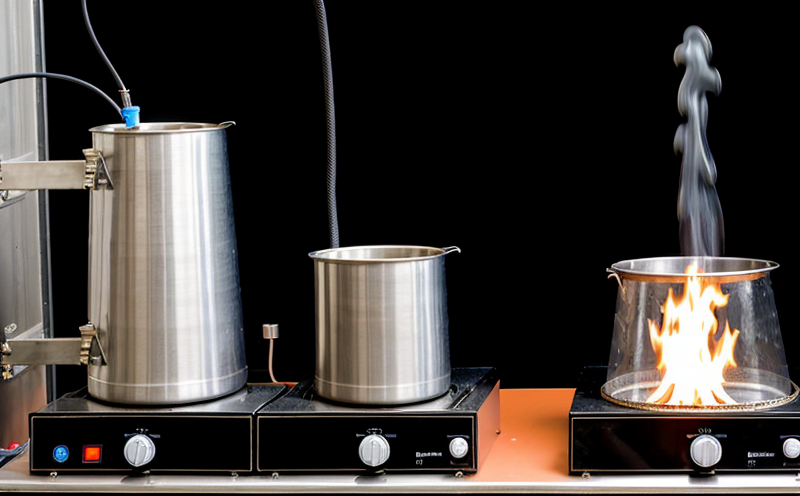Heat Release Testing of Marine Interior Materials
In marine environments, materials used in interior fittings and furnishings must meet stringent fire safety standards. Heat release testing is a critical component of ensuring these materials do not contribute to the spread of fire or provide an ignition source when exposed to flame. This testing assesses the amount of heat released by a material during combustion, which helps determine its flammability and the potential for fire growth.
The test method used most commonly in this context is ISO 16921:2017, Standard Test Method for Heat Release Rate of Textiles Used in Interior Furnishings. This standard defines a procedure to measure heat release rate (HRR) and oxygen consumption calorimetry (OCC) under controlled laboratory conditions.
During the test, specimens are exposed to an ignition source, typically a burner, for a specified duration. The combustion characteristics of the specimen are then measured using instruments that can capture both HRR and OCC data. This information is crucial for assessing not only the fire risk but also the potential impact on crew safety in confined spaces.
The testing process involves several key steps:
- Specimen Preparation: Samples must be cut to specific dimensions as per ISO 16921, ensuring they are representative of real-world conditions and can simulate the actual behavior under fire.
- Ignition Source: A standard burner, such as a DIN burner or an equivalent, is used to expose the specimen to flame. The type of ignition source chosen depends on the specific requirements of the test.
- Data Collection: Instruments like calorimeters measure the heat release and oxygen consumption during combustion. This data provides insights into the material's flammability characteristics.
- Post-Test Analysis: After the specimen is removed from the flame, the remaining char is weighed to assess mass loss. This helps in determining the total energy released by the material.
The results of heat release testing are essential for compliance with regulations such as IMO (International Maritime Organization) and USCG (United States Coast Guard). These organizations have established criteria that materials used in marine interiors must meet to ensure safety at sea. Compliance ensures not only regulatory adherence but also enhances the overall safety of crew members, passengers, and vessels.
Understanding the fire behavior of materials is crucial for designing safer ships and reducing the risk of catastrophic fires. The insights gained from heat release testing can inform design decisions, material selection, and operational practices to minimize fire hazards in marine environments.
Industry Applications
| Application Area | Description |
|---|---|
| Marine Interior Designers and Manufacturers | Evaluate the fire performance of materials used in ship interiors. |
| Regulatory Compliance Officers | Ensure compliance with IMO and USCG standards for marine interior materials. |
| R&D Engineers | Develop new fire-resistant materials and improve existing designs. |
| Procurement Specialists | Select suppliers who meet stringent fire safety requirements for marine products. |
| Safety Officers | Analyze the risk posed by different materials to crew and passengers. |
| Inspection Authorities | Verify that ships meet fire safety standards before certification. |
Quality and Reliability Assurance
The reliability of heat release testing is paramount in ensuring the safety of marine environments. The accuracy of calorimetric instruments and the consistency of sample preparation are critical factors that affect test results. Laboratories must adhere to strict calibration procedures and maintain traceability to international standards.
Regular audits and quality control measures ensure that each test adheres to ISO 16921:2017, ensuring consistent and reliable data. This consistency is essential for comparing results across different laboratories and for validating the effectiveness of fire safety improvements over time.
In addition to technical proficiency, laboratories must also consider environmental factors such as temperature and humidity when conducting tests. These conditions can significantly impact the behavior of materials during combustion, influencing the test outcomes. Therefore, controlled environments are crucial to obtaining accurate results.
The reliability of heat release testing is not only about the equipment used but also the expertise of the personnel performing the tests. Trained professionals ensure that each step of the process is executed correctly and consistently, contributing to the overall quality and reliability of the test results.
Environmental and Sustainability Contributions
The fire safety testing of marine interior materials also plays a role in promoting environmental sustainability. By ensuring that materials used on ships are flame retardant, the risk of accidental fires is significantly reduced. This reduction in fire incidents can lead to fewer casualties and less damage to vessels, which in turn minimizes the need for costly repairs and replacements.
Additionally, using fire-resistant materials can help prevent the spread of pollution from shipwrecks or accidents at sea. When ships catch fire, they may release harmful chemicals into the environment if these chemicals are not properly contained by fireproof barriers. By ensuring that all interior materials meet rigorous fire safety standards, we can mitigate this risk and protect marine ecosystems.
The testing process itself also contributes to sustainability efforts. Laboratories that conduct heat release tests must adhere to strict environmental regulations regarding waste disposal and energy consumption. This commitment to green practices ensures that the entire lifecycle of fire safety testing is environmentally responsible.





